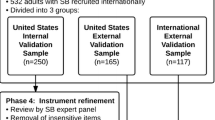Abstract
Purpose
Based on existing questionnaires and patient interview, a health-related quality of life (HRQoL) questionnaire in spina bifida (SB) children is created and validated, the Spina Bifida Pediatric Questionnaire (SBPQ).
Methods
SB patients from the SB reference centre Ghent University Hospital, Belgium, with mental ability between 6 and 18 years old and their parents were asked to participate in the study, together with a control group.
Results
Thirty-nine patients and parents answered the questionnaire once, 20 patients and their parents the test-retest. Thirty-five controls answered the questionnaire once, 34 controls and their parents the test-retest. The final questionnaire was retained when 3 consecutive patients approved all items. Visual clues were added for children with a mental ability below 10 years of age. The test-retest showed a good to excellent agreement for child self-report in 5 domains (not for social functioning), for parent proxy report in all domains (6), for control self-report in 4 domains (not for domain home) and for control parent proxy report in all domains (5). Internal consistency reliability was good in child self-report and in parent proxy report, except for physical functioning in child self-report. There was parent–child agreement for 4 out of 6 domains. Regarding social and emotional functioning, QoL was rated lower by parents than by children themselves.
Conclusion
A SB HRQoL questionnaire was developed and validated. Because of visual aid, this questionnaire can be used by both young children and adolescents.
Similar content being viewed by others
References
Vinck A, Nijhuis-van der Sanden MW, Roeleveld NJ, Mullaart RA, Rotteveel JJ, Maassen BA (2010) Motor profile and cognitive functioning in children with spina bifida. Eur J Paediatr Neurol 14(1):86–92
Bomalaski MD, Teague JL, Brooks B (1995) The long-term impact of urological management on the quality of life of children with spina bifida. J Urol 154:778–781
Bowman RM, Mc Lone DG, Grant JA, Tomita T, Ito JA (2001) Spina bifida outcome: a 25 year prospective. Pediatr Neurosurg 34:114–120
Bol KA, Collins JS, Kirby RS, National Birth Defects Prevention Network (2006) Survival of infants with neural tube defects in the presence of folic acid fortification. Pediatrics 117(3):803–813
Barf HA, Post MW, Verhoef M, Gooskens RH, Prevo AJ (2010) Is cognitive functioning associated with subjective quality of life in Young adults with spina bifida and hydrocephalus? Rehabil Med 42(1):56–59
Kulkarni AV, Rabin D, Drake JM (2004) An instrument to measure the health status in children with hydrocephalus: the hydrocephalus outcome questionnaire. J Neurosurg 101:134–140
Nanigian DK, Nguyen T, Tanaka ST, Canbio A, DiGrande A, Kurzrock EA (2008) Development and validation of the Fecal Incontinence and Constipation Quality of life measure in children with spina bifida. J Urol 180:1770–1773
Ok JH, Kurzrock EA (2011) Objective measurement of quality of life changes after ACE malone using FICQOL survey. J Pediatr Urol 7(3):389–393
Rathod KJ, Mahajan JK, Khan RA, Rao KL (2012) Quality of life of very young spina bifida patients after initial surgical treatment. Childs Nerv Syst 28(6):883–887
Varni JW, Seid M, Rode CA (1999) The PedsQL: measurement model for the paediatric quality of life inventory. Med Care 37(2):126–139
de Wit M, Winterdijk P, Aanstoot HJ et al (2012) Assessing diabetes-related quality of life in youth with diabetes type 1 in routine clinical care: the Mind Youth Questionnaire (MY-Q). Pediatr Diabetes 13(8):638–646
Scientific Advisory Committee of the Medical Outcome Trust (2002) Assessing health status and quality of life instruments attributes and review. Qual Life Res 211:193–205
Mc Graw KO, Wong SP (1996) Forming inferences about some intraclass correlation coefficients. Psychol Methods 1:30–46
Seid M, Limbers CA, Driscoll KA, Opipari-Arrigan LA, Gelhard LR, Varni JW (2010) Reliability, validity, and responsiveness of the Pediatric Quality of Life Inventory™ (PedsQL™) Generic Core Scales and Asthma Symptoms Scale in vulnerable children with asthma. J Asthma 47:170–177
Varni JW, Limbers CA, Burwinkle TM (2007) Impaired health-related quality of life in children and adolescents with chronic conditions: A comparative analysis of 10 disease clusters and 33 disease categories/severities utilizing the PedsQL™ 4.0 Generic Core Scales. Health Qual Life Outcomes 5(43):1–15
Varni JW, Limbers CA, Bryant WP, Wilson DP (2009) The PedsQL™ Multidimensional Fatigue Scale in Type 1 diabetes: Feasibility, reliability, and validity. Pediatr Diabetes 10:321–328
Palmer SN, Meeske KA, Katz ER, Burwinke TM, Varni JW (2007) The PedsQL™ Brain Tumor Module: Initial reliability and validity. Pediatr Blood Cancer 49:287–293
Mc Horney CA, Tarlow AR (1995) Individual-patient monitoring in clinical practice: are available health status surveys adequate? Qual Life Res 4:293–307
Hetherington R, Dennis M, Barnes M et al (2006) Functional outcome in young adults with spina bifida and hydrocephalus. Childs Nerv Syst 22:117–124
Padua L, Rendeli C, Rabini A, Girardi E, Tonali P, Salvaggio E (2002) Health-related quality of life and disability in young patients with spina bifida. Arch Phys Med Rehabil 83:1384–1388
Minchom PE, Ellis NC, Appleton PL, Lawson V, Böll V, Jones P, Elliott CE (1995) Impact of functional severity on self concept in young people with spina bifida. Arch Dis Child 73:48–52
Varni JW, Seid M, Smith Knight T, Burwinkle T, Brown J, Szer I (2002) The PedsQL™ in pediatric rheumatology. Reliability and validity and responsiveness of the Pediatric quality of life inventory ™ generic scores scales and rheumatology modules. Arthritis Rheum 46(3):714–725
Acknowledgments
Laura Mertens, Jozefien Haeve and Laurien De Ruyck are Masters students.
All procedures performed in studies involving human participants were in accordance with the ethical standards of the institutional and/or national research committee and with the 1964 Helsinki declaration and its later amendments or comparable ethical standards.
Conflict of interest
The authors declare that they have no competing interests.
Author information
Authors and Affiliations
Corresponding author
Rights and permissions
About this article
Cite this article
Velde, S.V., Laridaen, J., Van Hoecke, E. et al. Development and validation of a spina bifida-specific pediatric quality of life questionnaire: the Spina Bifida Pediatric Questionnaire, SBPQ. Childs Nerv Syst 32, 105–110 (2016). https://doi.org/10.1007/s00381-015-2903-3
Received:
Accepted:
Published:
Issue Date:
DOI: https://doi.org/10.1007/s00381-015-2903-3




